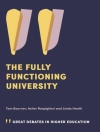Wildlife conservation and other environmental protection projects can have tremendous impact on the lives and livelihoods of the often mobile, difficult-to-reach, and marginal peoples who inhabit the same territory. The contributors to this collection of case studies, social scientists as well as natural scientists, are concerned with this human element in biodiversity. They examine the interface between conservation and indigenous communities forced to move or to settle elsewhere in order to accommodate environmental policies and biodiversity concerns. The case studies investigate successful and not so successful community-managed, as well as local participatory, conservation projects in Africa, the Middle East, South and South Eastern Asia, Australia and Latin America. There are lessons to be learned from recent efforts in community managed conservation and this volume significantly contributes to that discussion.
Table des matières
List of Tables and Figures
Preface
Acknowledgements
Notes on Contributors
Chapter 1. Introduction: Conservation and Mobile Indigenous Peoples
Dawn Chatty and Marcus Colchester
Chapter 2. Negotiating the Tropical Forest: Colonizing Farmers and Lumber Resources in the Ticoporo Reserve
Miguel Montoya
Chapter 3. Compatibility of Pastoralism and Conservation? A Test Case using Integrated Assessment in the Ngorongoro Conservation Area, Tanzania
Kathleen A. Galvin, Jim Ellis, Randall B. Boone, Ann L. Magennis, Nicole M. Smith, Stacy J. Lynn, Philip Thornton
Chapter 4. Giving Conservation a Human Face? Lessons from Forty Years of Combining Conservation and Development in the Ngorongoro Conservation Area, Tanzania
J. Terrence Mc Cabe
Chapter 5. National Parks and Human Ecosystems: The Challenge to Community Conservation. A Case Study from Simanjiro, Tanzania
Jim Igoe
Chapter 6. The Mursi and the Elephant Question
David Turton
Chapter 7. Forced Resettlement, Rural Livelihoods and Wildlife Conservation along the Ugalla River in Tanzania
Eleanor Fisher
Chapter 8. The Influence of Forced Removals and Land Restitution on Conservation in South Africa
Christo Fabricius and Chris de Wet
Chapter 9. How Sustainable is the Communalizing Discourse of ‘New’ Conservation? The Masking of Difference, Inequality and Aspiration in the Fledgling ‘Conservancies’ of Namibia
Sian Sullivan
Chapter 10. Representing the Resettled: The Ethical Issues Raised by Research and Representation of the San
Sue Armstrong and Olivia Bennett
Chapter 11. Negev Bedouin: Displacement, Forced Settlement and Conservation
Aref Abu-Rabia
Chapter 12. Customs Excised: Arid Land Conservation in Syria
Jonathan Rae, George Arab and Tom Nordblom
Chapter 13. Animal Reintroduction Projects in the Middle East: Conservation without a Human Face
Dawn Chatty
Chapter 14. Environmental Conservation and Indigenous Culture in a Greek Island Community: The Dispute over the Sea Turtles
Dimitrios Theodossopoulos
Chapter 15. Displacement and Forced Settlement: Gypsies in Tamilnadu
Daniel Meshack and Chris Griffin
Chapter 16. Karen and the Land in Between: Public and Private Enclosure of Forests in Thailand
Jin Sato
Chapter 17. Lost Worlds and Local People: Protected Areas Development in Viet Nam
Pamela Mc Elwee
Chapter 18. The History of Displacement and Forced Settlement in West Kalimantan, Indonesia: Implications for Co-managing Danau Sentarum Wildlife Reserve
Reed L. Wadley
Chapter 19. Planning for Community-based Management of Conservation Areas: Indigenous Forest Management and Conservation of Biodiversity in the Kayan Mentarang National Park, East Kalimantan, Indonesia
Cristina Eghenter
Chapter 20. Resettlement and Natural Resources in Halmahera, Indonesia
Christopher R. Duncan
Chapter 21. Welcome to Aboriginal Land: Anangu Ownership and Management of Uluru-Kata Tjuta National Park
Graham Griffin
Index of Subjects
Index of Names
A propos de l’auteur
Dawn Chatty is General Editor of Studies in Forced Migration and teaches at the Center for Refugee Studies of the University of Oxford.












